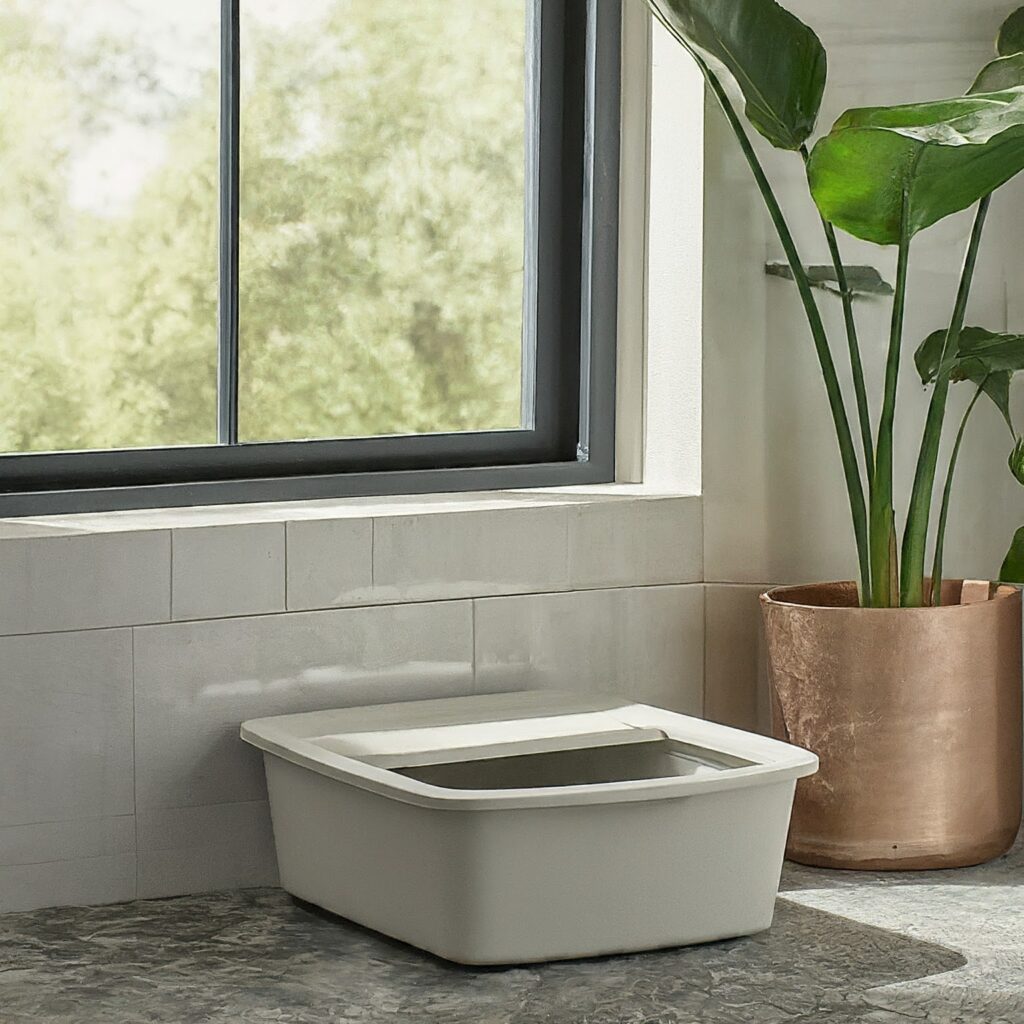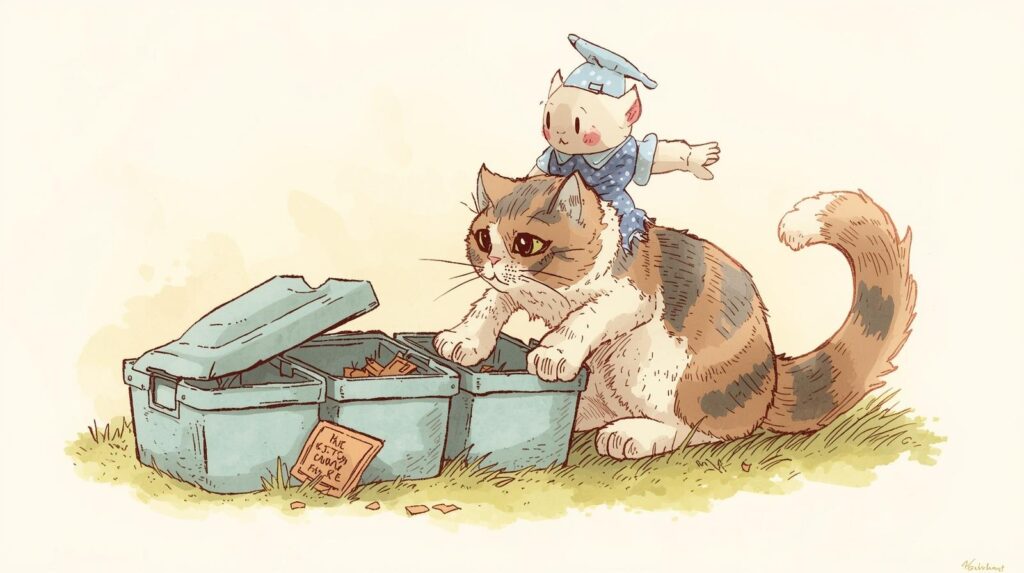
How to get cat to use litter box? Start by choosing the right litter box and litter, placing it in a quiet area, and cleaning it daily. Use positive reinforcement, like treats, when your cat uses it correctly. If problems continue, rule out medical issues like UTIs or stress triggers. With the right approach, most cats adapt quickly.
3 Quick Tips to Begin Today:
- Scoop daily and keep the litter box spotless
- Choose unscented, soft-texture clumping litter
- Place boxes on every floor of the house
Table of Contents
How to Get Cat to Use Litter Box: 3 Simple Vet-Approved Steps

Getting your cat to consistently use the litter box begins with aligning your setup and approach with a cat’s natural instincts and physical needs. According to feline behavior experts and veterinarians, here’s what truly works:
Step 1: Health First — Always Rule Out Medical Issues
Before making behavioural assumptions, have your cat examined for UTIs, kidney infections, digestive troubles, or arthritis. These are the leading causes behind sudden litter box rejection. Senior cats are especially vulnerable.
Step 2: Location and Environmental Fit
Place the litter box in a quiet, low-traffic area—away from noisy appliances, children’s rooms, and pet feeding zones. Avoid cornering the cat, as they dislike confined, escape-proof spots.
Step 3: Box + Litter Match Their Preference
Most cats prefer a large, uncovered box and unscented clumping litter. Avoid automatic boxes until the cat is fully trained and stress-free. Also, test for texture sensitivity—some cats dislike pellet-based or crystal litters.
Expert Tip: If your cat keeps sniffing but not using the box, it could be the litter depth. Maintain 2–3 inches of clean litter at all times.
Expert Box Setup: Best Litter Box, Litter, and Location Combo
An optimised litter box setup is the #1 game-changer in getting your cat to use it confidently and repeatedly. Based on what behaviourists, breeders, and vets suggest, here’s a complete setup checklist:
Choose the Right Litter Box:
- Size Matters: A litter box should be 1.5x the length of your cat from nose to base of tail.
- Uncovered > Covered: While some cats are okay with covered boxes, most dislike trapped odours and enclosed spaces.
- Low Sides for Kittens/Seniors: Older cats or tiny kittens need low-entry boxes for easy access.
Choose the Right Litter:
- Clumping, unscented, soft texture = best acceptance rate
- Avoid perfumed, pine, or pellet litters unless your cat is already used to them
- Scoop daily to prevent smell buildup and litter aversion
Best Location Rules:
- Never next to food, water, or noisy areas (e.g., laundry machines)
- Avoid tight corners where a cat may feel trapped or ambushed
- Multiple cats = multiple boxes in separate areas (not side by side)
Bonus Tip: A quiet, low-light corner with easy exit routes boosts your cat’s confidence, especially in multi-pet homes.
Breakthrough: How to Get Cat to Use Litter Box with Positive Reinforcement
Positive reinforcement is one of the most effective and science-backed strategies to change feline behaviour naturally. Instead of punishing a cat for accidents (which often causes more stress), reward the cat when it uses the litter box correctly.
Here’s how to make this breakthrough work:
- Clicker Train: Use a clicker sound the moment your cat enters the box, then follow up with a high-value treat.
- Consistency is Key: Always reward within 3 seconds of correct behaviour.
- Timing Matters: Reinforce after meals, naps, or play—when cats are more likely to eliminate.
Avoid These Mistakes When Training Your Cat
Many cat owners unknowingly create conditions that push their cat away from the litter box. Understanding what not to do is just as vital as the correct method.
Critical Mistakes to Avoid:
- Using Scented Litter: These often smell nice to humans but are overpowering to cats.
- Box Near Noisy Areas: Placing boxes near washing machines or high-traffic zones creates anxiety.
- Ignoring Accidents: Cats return to places that smell like previous waste—clean with enzyme cleaners only.
- One Box for Multiple Cats: This leads to territory battles and anxiety. Follow the “one box per cat plus one” rule.
Pro Tip: Never punish your cat for accidents—this breaks trust and increases anxiety-driven avoidance.
You may also read and enjoy:
Little-Known Tricks That Work
Sometimes, a few “secret tricks” make a big difference, especially for tricky or rescued cats.
Try These Advanced Hacks:
- The “Poop Trail” Trick: Leave a small piece of soiled litter in the new box so the scent leads them back.
- Litter Attractant Powders: Available in pet stores; used to encourage box usage in resistant cats.
- Use a Timer: Place your cat in the box 15–20 minutes after meals or play. Timing increases success.
- Pheromone Diffusers: Tools like Feliway help reduce anxiety-based refusal.
You may also read:
Senior & Special Needs Cats – Tailored Litter Box Solutions That Work
Older cats and cats with disabilities need more than just a standard litter box—they need comfort, accessibility, and thoughtful adjustments. Their bodies may not move the way they once did, and that can directly impact litter box success.
Why Senior Cats Struggle:
- Arthritis or joint pain can make it hard to step over high box sides.
- Decreased bladder control increases urgency.
- Declining senses (smell, sight, or hearing) may make it harder for them to locate the box.
What They Need:
- Low-entry litter boxes: Look for boxes with 3-inch-high entry points to ease mobility.
- Soft, fine-grain litter: Avoid heavy pellets or rough textures that may hurt sensitive paws.
- Multiple boxes on each floor: Reduce the need for climbing stairs.
- Proximity is power: Place a box near their favourite napping spots.
Bonus Tip:
Place a heated mat or blanket near the litter box area—warmth can encourage older cats to get up and move more frequently.
Troubleshooting Guide – How to get cat to use litter box
If you’ve tried everything—clean boxes, ideal placement, positive reinforcement—and your cat is still avoiding the litter box, don’t panic. This is a signal, not defiance. It means your cat is trying to tell you something.
Step 1: Recheck for Underlying Medical Issues
Even if your cat had a clean bill of health last month, new problems like:
- Urinary Tract Infections (UTIs)
- Bladder crystals or inflammation
- Chronic kidney disease
- Constipation or diarrhea
…can trigger avoidance. Schedule a vet visit and ask for a urinalysis, faecal exam, or X-ray if symptoms persist.
Step 2: Track Behaviour Patterns
Start keeping a simple log for a few days:
- Where are accidents happening?
- What time of day?
- Any stressors (new pet, noise, visitors)?
- Is your cat avoiding just one box or all of them?
Sometimes, the location or social dynamics in multi-pet homes cause litter box refusal.
Step 3: Deep Clean Accident Areas Properly
If a cat smells old urine or faeces in a spot outside the box, they’ll likely go there again.
- Use only enzyme-based cleaners (not vinegar or bleach)
- Block off frequently soiled areas temporarily
- Spray with a deterrent like Feliway No Marking
Step 4: Apply Environmental & Behavioural Fixes
- Add a new litter box in a different spot
- Try a different litter type (fine, unscented, low-dust)
- Reintroduce clicker training + rewards
- In multi-cat homes, reduce tension with separate feeding and litter areas
Cleanliness Rules That Make a Cat Use the Litter Box
If you’re searching “why won’t my cat use the litter box even though it’s clean?” or “how often to scoop cat litter,” this section gives you exact answers that solve the real problem: how your cat defines “clean” is very different from how you do.
What Clean Means to a Cat:
- Cats have 14x stronger smell than humans. What seems “fresh” to you may reek to them.
- One pee clump or one poop can signal to them: “go elsewhere.”
Daily, Weekly, Monthly Cleaning Plan:
- Scoop poop and pee at least once or twice a day
- Refill low spots with fresh litter (don’t wait until it’s gone!)
Weekly:
- Fully empty all litter
- Scrub the box with warm water + mild soap
- Avoid vinegar, bleach, or citrus-based cleaners—they’re too strong
Monthly:
- Replace the box every 6–12 months (scratches trap odours permanently)
- Check for litter dust buildup or stickiness under mats
Common Cleaning Mistakes That Push Cats Away:
- Using scented litter or air fresheners
- Not drying the box completely after cleaning
- Liners and pads can trap smells underneath
- Leaving waste too long leads to odour buildup and bacteria
Transition Tips – Training Kittens & Re-Training Adult Cats Without Stress
If you’re asking “How do I train my kitten to use the litter box?” or “Can I re-train an older cat?”, the good news is: yes, you can—with the right timing, placement, and consistency. Whether it’s a tiny kitten or a grown rescue cat, the steps below are tailored to real cat behaviour.
For Kittens (8 Weeks+): Teach Early, But Gently
Kittens learn by habit and scent. Here’s how to make it natural:
- Place the litter box in the same room where they eat, play, or sleep.
- Right after meals, naps, or playtime, gently place them in the box.
- Use the “poop trail trick”: leave a small amount of their previous waste in the box to help them follow the scent.
Avoid litter types that clump or have dust—kittens may accidentally ingest it.
For Adult Cats: Reset the Habit with Patience
Older cats, especially rescues, may come with trauma, bad experiences, or no litter training background. Here’s what works:
- Start with a single box in a quiet, safe room
- Introduce one litter type at a time
- Watch for “pre-potty” behaviours: sniffing, circling, or digging—gently guide them to the box when seen
- Use treats or praise immediately after a successful litter use
Repetition builds trust: It may take 5–10 days of consistent guidance before behaviour is learned.
What to Never Do (Especially with Rescues or Nervous Cats)
- ❌Don’t yell or punish—they’ll hide or stop eliminating altogether
- ❌ Don’t force them into the box—they must feel it’s their choice
- ❌ Don’t keep changing litter brands during training—it confuses them.
Maintenance Plan – How to Keep Your Cat Using the Litter Box Forever
Many people search for things like:
- How do I keep my cat using the litter box consistently?
- Why did my cat suddenly stop using the litter box again?
The truth is: even after successful training, bad maintenance or small changes can cause relapse. Cats are creatures of habit, and their bathroom habits rely on routine, cleanliness, and predictability.
What Triggers a Trained Cat to Suddenly Stop Using the Box?
Dirty box even for just 1 day
- Moved the box to a loud or open space
- New litter or box without transition
- New pet, guest, or stressor near the box
- Old scent in accident areas is not cleaned with enzymes
Use Tools to Track & Reinforce the Habit
- Use apps like “Pet Diary” or “CatBuddy” to track usage
- Create a reminder system for daily scooping & weekly washes
- Keep a litter box journal if problems return
FAQs: How to get cat to use litter box
1. How quickly can a cat learn to use the litter box?
Most cats learn within a few days to a week, especially if trained young and with positive rewards.
2. What’s the best litter for kittens vs adult cats?
Kittens need non-clumping litter early on to avoid ingestion risks; adults do best with unscented clumping litter.
3. Why does my cat pee outside the litter box suddenly?
Causes include UTIs, stress, territory marking, or dirty boxes. Always start with a vet check.
4. How many litter boxes should I have?
One per cat, plus one extra, is the golden rule. For 2 cats, that’s 3 boxes.
5. Does a covered litter box stop tracking litter?
No—it may increase odour and deter use. Open boxes are preferred by most cats.
6. Can stress make a cat avoid the litter box?
Yes, cats are sensitive. Moves, loud noises, or new pets can trigger avoidance.
7. How do I toilet train a cat instead?
It’s possible but not recommended. Natural litter box behaviour is healthier and easier to maintain.
8. Is scented litter bad for cats?
Yes—many cats dislike strong scents and may avoid the box. Use unscented options.
Wrapping it all up: How to get cat to use litter box
If you’re wondering “Will my cat ever use the litter box again?” or “How do I stop litter box accidents forever?”—the answer is yes, but only if you listen to what your cat is trying to tell you.
Cats aren’t being stubborn—they’re communicating discomfort, stress, or confusion. To fix it long-term:
- Start with a clean, consistent litter box setup
- Address any health or anxiety triggers
- Reinforce good behaviour with gentle praise and positive rewards
- Stick to a routine—cats thrive on stability
Whether you’re training a kitten or retraining a rescue, patience + understanding = lifelong success. With the steps outlined in this guide, you’re not just solving a litter box problem—you’re building trust and harmony between you and your cat



